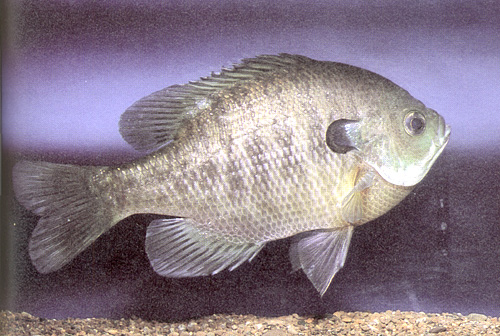
photo by William D. Schmid
Bluegill
Lepomis macrochirus (Rafinesque, 1819)
member of the Sunfish Family (Centrarchidae)

photo by William D. Schmid
|
|
What's
In a Name? |
||
| Where
Do They Live? The bluegill lives throughout Minnesota, but it is most abundant in the central area of the state. This popular pan fish lives in the shallows of many lakes and ponds where it is warm and weedy, and in slow moving parts of streams and small rivers that have a lot aquatic plants. It is absent in many of the lakes of northeastern Minnesota because that water is too cold for them. Bluegills often are among the weed beds searching for food or spawning. In the warmest parts of the summer, the bigger adults go to deeper water, which might be as deep as 6 m (20 ft). This fish shares its habitat with many other fishes, such as other types of sunfish, northern pike, largemouth bass or smallmouth bass, white suckers, and many species of minnows. |
|||
|
How
Big Do They Get? Many bluegills reach the age of 5 to 8 years and in extreme cases may reach 11 years old. In some lakes, bluegills become too numerous and a stunted population results. These fish often do not live beyond 4 years and rarely exceed 90 mm (3.5 in) in length. |
|||
| What
Do They Eat? The young bluegill's diet is commonly rotifers and a variety of waterfleas. The adult bluegill's diet is mostly aquatic insect larvae (such as mayflies, caddisflies, and dragonflies), but also includes crayfish, leeches, snails, and sometimes small fish. Of course, the angler's bit of nightcrawler or waxworm is also on the menu. Bluegills are often taken on popping bugs and dry flies because they sometimes feed on insects "hatching" at the water's surface. (These insects are not hatches from eggs. They are breaking out of their last larval skin and becoming flying adults). |
|||
|
What
Eats Them? |
|||
|
How
Do They Reproduce? Sometimes a smaller male hides in the nearby weeds. Just as the spawning act begins, he darts into the nest between the resident male and female and releases sperm. Then he hightails it back to the weeds. These little guys are called "sneakers" and it's easy to tell why. The size of the female has a large effect on how many eggs she will produce. The number can range from 1,000 in stunted fish to nearly 70,000 in a large, healthy fish. A single nest typically will have 10,000-100,000 eggs (they are really embryos) in it usually from several different females. The male continues to fan the embryos and protect the nest. When the larvae hatch they spend a few days "wriggling" in the nest before they swim up into the water column. At that point, they are on their own. |
|||
|
Conservation
and Management |
Permission is granted for the non-commercial educational or scientific use of the text and images on this Web document. Please credit the author or authors listed below.
Photographs by William D. Schmid
Text by Nicole Paulson & Jay T. Hatch in
cooperation with
the Minnesota Department of Natural Resources' MinnAqua Aquatic Program
This page developed with funds from the
MinnAqua Program
(Minnesota Department of Natural Resources, Division of Fisheries)
and the
Sport Fish Restoration
Program (Fish and Wildlife Service, US Department of the Interior)
Maintained by Jay T. Hatch
General College and James
Ford Bell Museum of Natural History
University of Minnesota, Minneapolis/St.
Paul
Last updated 18 June 2004